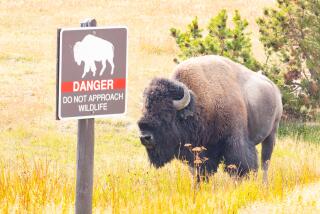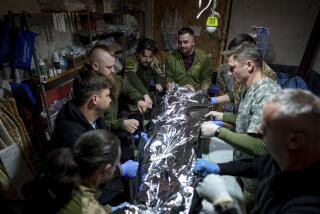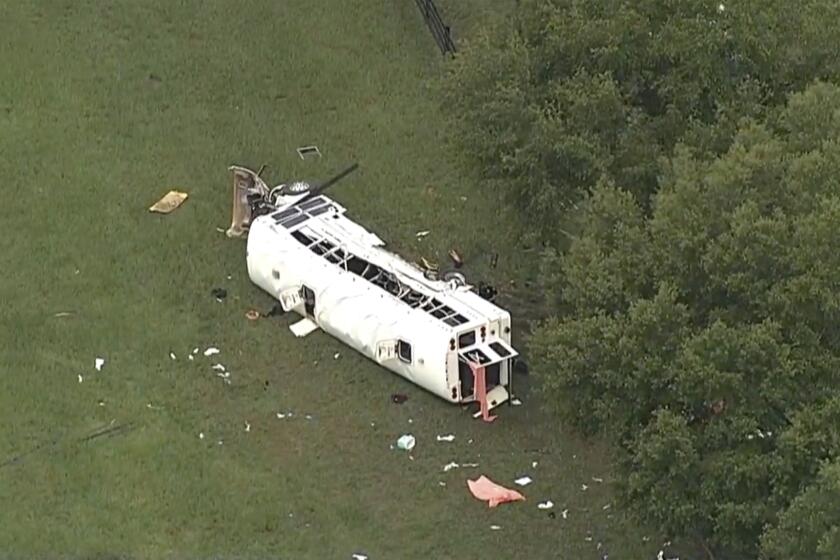State Seeks Pipeline, Not Pipe Dream
Surrounded by an endless forest of black spruce, this town along the Alaska Highway barely scratches out a living. Farming is marginal. The nearby Army base is closing. Plans to build a prison fell through.
“There ain’t much going on around here,” says Larry Marksmeier. Dressed in a flannel shirt and a cap advertising Fisher Snowplows, Marksmeier stands on the oil-stained floor of Delta Auto and Truck Repair, which he and his son opened last winter.
The shop is quiet--too quiet--but Marksmeier, age 62, has great hopes that business soon will improve. A natural gas pipeline from the North Slope may be coming through here, and for Marksmeier and many other Alaskans, the mere possibility is enough to make dollar signs swirl like snowflakes before their eyes.
Never mind that the multibillion-dollar project will take years to complete--if it ever gets started. Never mind that there’s no guarantee it won’t bypass most of Alaska and go through Canada instead.
In a state with a history of lurching from one boom to the next, many people welcome the prospect of a big gas line project as revenues fade from the last boom--oil production at Prudhoe Bay.
“There would be a lot more business for us,” Marksmeier says. “Once you get the construction workers in, there will be possibilities. There’ll be people moving into Delta for a while, maybe even staying. It would be a boom for Delta. I think that would be a good idea.”
Alaskans love big things. It has always been so. Pioneers driven by a Big Idea (often involving the promise of a Big Payoff) have been responsible for settling much of the Far North.
Fur traders and whalers came first, followed by Gold Rush prospectors, then soldiers building forts and roads during World War II. The greatest boom of all started in 1968, when vast reserves of oil were discovered at Prudhoe Bay.
Getting the oil to market involved the biggest construction project the state had ever seen: an 800-mile pipeline across tundra, forest and mountains from the North Slope to the ice-free port of Valdez.
The oil started flowing in 1977 and has dominated the state’s economy ever since. Though North Slope oil production is now at just half its 1988 peak, a state Permanent Fund created with oil revenues has grown to $28 billion. Last year it paid a dividend of $1,963 to every man, woman and child in Alaska.
The audacity of building a pipeline and huge industrial installation in the Arctic deep-freeze inspired bold proposals for other jumbo-sized projects. In the early 1990s, then-Gov. Walter Hickel backed plans for a $37-billion tunnel beneath the Bering Strait and a $150-billion undersea pipeline to move fresh water from Alaska to California. Both were shelved as unrealistic.
Other Alaska dreamers have--on paper, at least--blasted highways through glaciers with atomic bombs, pushed railroads across the wilderness and built all manner of huge dams, domed cities, and roads and bridges linking one sparsely inhabited region with another.
For years, a natural gas pipeline connecting the North Slope and the Lower 48 states was lumped with all the other Big Ideas gathering dust in government archives. The terrain was too rugged, natural gas was too plentiful and cheap down south, and the distance was too great to make the project pencil out.
Instead, oil companies reinjected the natural gas that came up with the crude oil they pumped from beneath the North Slope, figuring that the time would come, someday, when rising demand would make it worth their while to transport the gas to market.
That time may be at hand.
Natural gas prices have risen recently, with a likelihood of continued increases. The United States consumes about 22 trillion cubic feet of natural gas each year, and the federal Energy Department projects a 30% increase in demand by 2010 as electricity producers switch to gas from dirtier fuels such as oil and coal.
Known gas reserves under the North Slope total about 35 trillion cubic feet, with estimates of 100 trillion cubic feet yet to be discovered.
A gas consortium of BP Exploration (Alaska), Phillips Alaska and ExxonMobil Production is spending $75 million on studies for a gas pipeline from the North Slope, looking at two alternative routes.
One, favored by Alaska politicians and business leaders, would run south from Prudhoe Bay along the trans-Alaska oil pipeline to Delta Junction, then east along the Alaska Highway to hook up with existing pipelines in central Alberta.
The other would use an offshore line across the Beaufort Sea from Prudhoe Bay to Canada’s Mackenzie River Delta, then south along the river valley to northern Alberta.
Either way, it’s clear that a pipeline is no longer just a pipe dream.
“Over the next five years, this will be the big energy project in Alaska,” predicts BP spokesman Ronald Chappell. “Natural gas is the fuel of choice for electricity generation in North America.”
Pipeline fever is already spreading across Alaska. In the interior city of Fairbanks, a supportive crowd of 200 people attended the first public hearing about the proposed pipeline on April 18. In the town of Salcha, just up the road from Delta Junction, residents are talking about vocational training for middle-schoolers who would reach working age by the time pipeline construction began.
In the capital city of Juneau, lawmakers are so eager for the pipeline to head south through Alaska that both House and Senate recently passed a bill barring state agencies from granting leases for a pipeline heading east across the North Slope toward Canada. Gov. Tony Knowles says he’ll sign the legislation.
Pipeline boosters say the southern route would create jobs, increase property values for local governments and provide a ready source of natural gas for towns along the pipeline’s route.
“This is an insurance policy,” says state Rep. Jim Whitaker, a Fairbanks Republican. “This ensures that the people of this state will reap the benefits of the gas line.”
All the hoopla reminds economist Scott Goldsmith of the cargo cults of Melanesia. During World War II, he explains, the South Pacific islanders benefited greatly from goods emerging from the bellies of Allied airplanes. When the war ended and the planes stopped coming, the islanders built mock-ups of planes and airfields, hoping to lure the real planes back.
Goldsmith, with the Institute of Social and Economic Research at the University of Alaska Anchorage, says Alaskans will be as disappointed as the cargo cultists if they think construction of a gas pipeline will create another boom like the one surrounding the oil pipeline in the 1970s.
He predicts a “miniboom,” saying a big construction project would be absorbed more easily now by Alaska’s more diversified economy and larger population, today nearly 627,000 compared to 418,000 in the 1970s.
Goldsmith understands the allure of megaprojects, but he questions the wisdom of staking an economy to them rather than focusing on more sustainable industries such as tourism, mining, cargo shipping and high-tech.
“It’s a very traditional approach in Alaska. You build something big, and it will attract economic activity around it,” Goldsmith says. “But is that an appropriate development model for the 21st century? It’s a question we have to answer before we jump ahead with these big investments.”
Nowhere is the seduction of a boom more apparent than in Deadhorse, the service center for the Prudhoe Bay oil patch and the quintessential boomtown.
Pickup trucks and oversized construction vehicles rumble along the icy streets, frozen exhaust swirling in dense white clouds around them.
Hardly anyone actually lives here, but thousands of workers--90% of them men--come and go each month, pulling overtime at work camps before flying south for R&R.;
The glory days here are gone. The pipeline is pumping 1 million barrels a day, half the peak reached in 1988. But Prudhoe Bay is still a great place to make money. Strong oil prices, currently around $25 per barrel, have spurred development of new wells as well as a revisiting of old ones to extract more oil with new technology.
Sooner or later, nearly everyone stops in at the Prudhoe Bay General Store, which sells knives, duct tape, girlie magazines, insulated work clothes (size XXXX-Large is available, but not Small) and postcards from “America’s Finest Oilfield.”
“Business is great,” says Deborah Bernard, who runs the store with her husband, Joe. “There’s a boom going on right now. It’s busier here at the store than it’s been in five years.”
Joe Bernard sends each customer out the door with the same farewell. “Keep the dream alive!” he says as the men zip up their coats against the subzero cold outside.
“Everybody has a dream up here,” Bernard explains. “That’s the only way you can survive. You gotta have a dream, and most everybody’s dream is to get enough money and get the hell out of here.”
There is no assurance yet that the consortium of oil companies will go ahead with the gas pipeline. They say they hope to have enough information later this year to decide which route is preferred.
But their decision-making will be influenced by many factors outside Alaska, including the price and demand for natural gas, the cost of transporting gas from elsewhere in the world and the impact of flooding the U.S. market with Alaska natural gas.
“It’s all up in the air,” Marksmeier concedes, still standing in his lonely car-repair shop in Delta Junction.
Marksmeier remains hopeful, but he intends to stay regardless of whether the pipeline happens. He represents another Alaska phenomenon: With each passing boom, some people come to make a quick buck and then forget to leave. Marksmeier planned to stay three months when he moved up from Oregon. That was 12 years ago.
He has shivered in the bitter cold while driving a belly-dump truck on the North Slope haul road. He has managed a potato farm near Delta Junction, some years harvesting puny, plum-sized potatoes, other years growing football-size spuds too big to sell.
Alaska is never easy, but for some it holds an attraction that overcomes such petty concerns as how to make ends meet.
“I love it up here,” says Marksmeier. “There’s good hunting, good fishing. You don’t have the traffic to contend with. It’s a zoo down there.”
An Alaskan does have to learn patience, Marksmeier knows. Next door to his garage, rusting in snowdrifts, are a dozen pieces of heavy equipment, including a crane, bulldozer, forklift and dump truck.
Owned by a neighbor, they’ve been there for years. All are for sale, waiting with the rest of Delta Junction for the next boom to begin.
More to Read
Start your day right
Sign up for Essential California for news, features and recommendations from the L.A. Times and beyond in your inbox six days a week.
You may occasionally receive promotional content from the Los Angeles Times.





